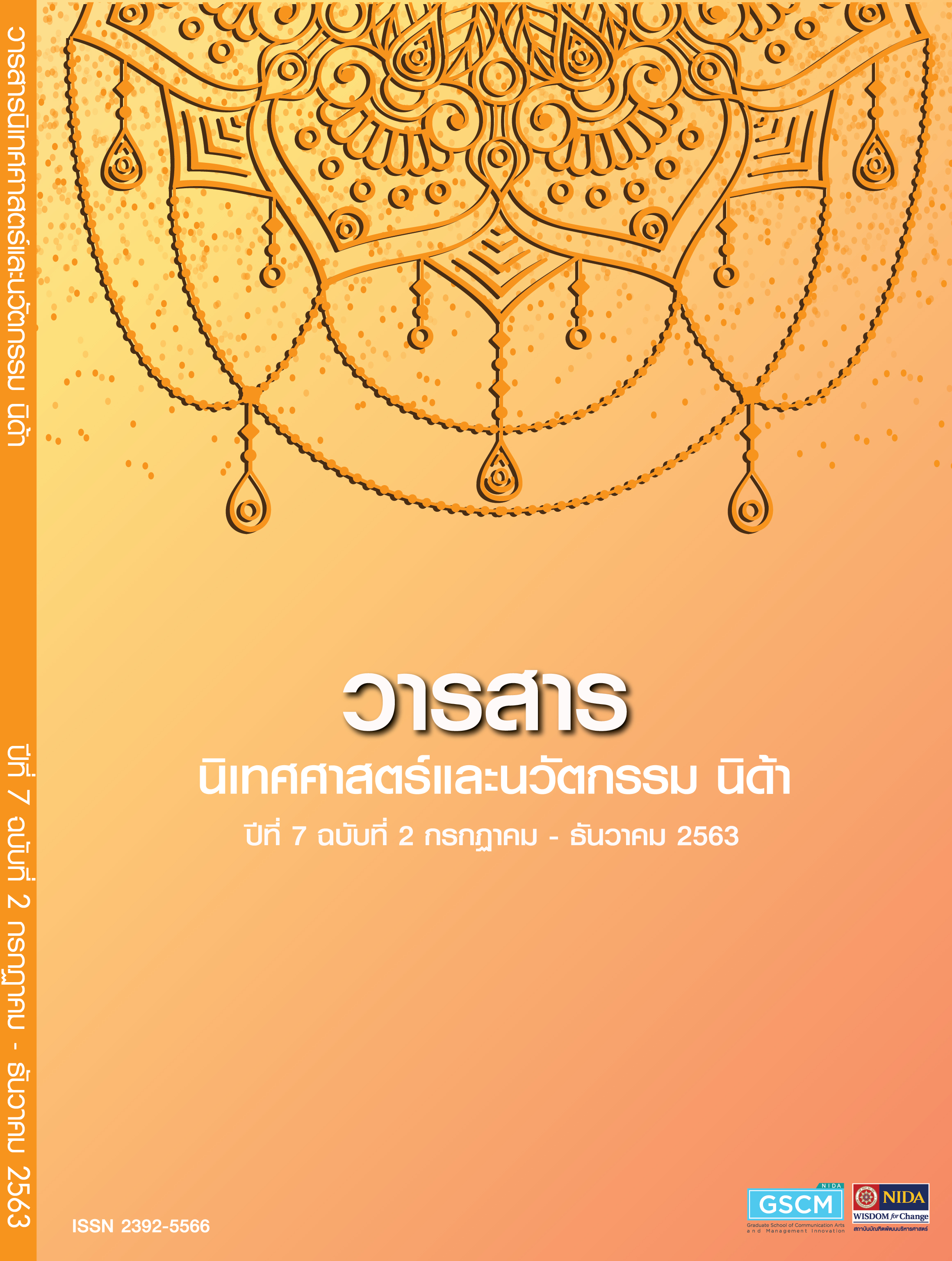The strategic planning process of online influencer marketing campaign in social media era
Main Article Content
Abstract
This research aims to study the strategic planning process of online influencer in social media era. The objectives of this research are 1. To study the marketing communication and planning process of online influencers in social media. 2. To study the success factors in marketing communication and planning of online influencers in social media.
This research is a qualitative study initiating with data collection including in-depth interviews. Interviewing marketers who have experience in online influencer marketing. Four interviewees from advertising agencies and two interviewees from two company brands.
The research results pointed out that the marketing communication and planning process of the online influencer in social media is a step-by-step process with 7 steps : Objective setting, Target audience selection, Influencer selection, Content setting, Budget setting, Monitoring and Evaluation. In addition, it was found that there are succeeding factors in the marketing communication and planning of the online influencer in social media :The importance of online media that is increasing nowadays, The online influencer has a greater role and influence for consumers. The online influencer can motivate and change consumer behavior and consumers are more willing to accept and trust advertising from online influences.
Article Details
ข้อความและความเห็นในวารสารนิเทศศาสตร์และนวัตกรรม นิด้า เป็นของผู้เขียนแต่ละท่าน มิใช่ของคณะนิเทศศาสตร์และนวัตกรรมการจัดการ สถาบันบัณฑิตพัฒนบริหารศาสตร์
References
กองบรรณาธิการนิตยสาร BrandAge. (2550). Brand Age Essential : Subdivision 5 : P number 4 (MarComm). กรุงเทพฯ : สำนักพิมพ์แบรนด์เอจ.
กานดา สุภาวศิน และคณะ. (2559). Re: Digital การตลาดยุคใหม่เจาะใจลูกค้า. กรุงเทพฯ: โปรวิชั่น.
ชัญญาภรณ์ แสงตะโก. (2560). อิทธิพลของ Micro-Influencer ต่อการตัดสินใจซื้อสินค้า High Involvement ประเภทรถยนต์นั่งส่วนบุคคล. วิทยานิพนธ์ปริญญานิเทศศาสตร์มหาบัณฑิต. มหาวิทยาลัยกรุงเทพ.
ณัฐพัชญ์ วงษ์เหรีญทอง. (2557). Content Marketing เล่าให้คลิกพลิกแบรนด์ให้ดัง. กรุงเทพมหานคร: เนชั่นบุ๊คส์.
ประดิษฐ์ จุมพลเสถียร. 2544. การสื่อสารการตลาดเชิงกลยุทธ์: กรุงเทพฯ: ห้างหุ้นส่วนจำกัดอาร์ตโปรเกรส: พิมพ์ครั้งที่ 1. 2544.
รติมา ศรีสมวงศ์, พิมพ์นลิน โกมลรุจิ, ทิวาพร รุ่งนาวา, บัณฑิตา สุดมี และพัลลภา ปีติสันต์. (2555). The Power of Influencer. QM for quality management, 18(173), 18-19
รัฐญา มหาสมุทร. (2558). กลยุทธ์การสื่อสารของผู้ทรงอิทธิพลทางความคิดในโลกออนไลน์ทีมีผลต่อทัศนคติของกลุ่มผู้ติดตาม. วิทยานิพนธ์ปริญญามหาบัณฑิต, สถาบันบัณฑิต พัฒนบริหารศาสตร์.
ลดาอาไพ กิ้มแก้ว (2560).ปัจจัยที่มีผลต่อความตั้งใจซื้อของผู้บริโภคจากสื่อโฆษณาประเภทวีดิโอผ่านผู้มีอิทธิพลทางความคิด. วิทยานิพนธ์ปริญญาบริหารธุรกิจมหาบัณฑิต, มหาวิทยาลัยธรรมศาสตร์
สิทธิ์ ธีรสรณ์, (2551), การตลาดจากแนวคิดสู่การปฏิบัติ, กรุงเทพฯ : จุฬาลงกรณ์ มหาวิทยาลัย.
อรรถชัย วรจรัสรังสี และ พนม คลี่ฉายา. (2556). ประเภทเนื้อหาการตลาดบนเฟสบุกแฟนเพชและความตั้งใจซื้อของผู้บริโภค. (วิทยานิพนธ์มหาบัณฑิต, มหาวิทยาลัยจุฬาลงกรณ์มหาวิทยาลัย).
Brandbuffet (2561, 20 มิถุนายน). REVU แพลตฟอร์มแห่งการ “รีวิว” ก้าวสู่ปีที่ 2 เพราะพลังแห่งMicro Influencer ช่วยสร้างกระแสของแบรนด์ได้. สืบค้นจาก https:// www.brandbuffet.in.th/2018/06/revu-platform-micro-influencer-2nd-years/
Posttoday. (2562,8 กุมภาพันธ์). Tellscore แพลตฟอร์ม‘Influencers Marketing. สืบค้นจาก https://www.posttoday.com/market/news/579647 .
Thumbsup. (2559, 6 ธันวาคม). นักการตลาด 39% เล็งเพิ่มงบประมาณ influencer marketing อีกปีหน้า. สืบค้นจาก https://thumbsup.in.th/2017/12/influencer-marketing-budgets/.
TWF Digital. (2561, 2 ธันวาคม). คาดการณ์ Digital Marketing Trends ปี 2019. สืบค้นจาก https://www.twfdigital.com/blog/2018/12/thailand-digital-marketing-trends-2019/
Ennew, C. T., Aishisk, K. B., & Derek, L. I. (2000). Managing word of mouth communication: Empirical evidence from India. International Journal of Bank Marketing, 18(2), 75–83.
Jason Lankow, Josh Ritchie and Ross Crooks (2012). Infographic: The Power of Visual Storytelling. USA. John Wiley and Sons.
Kaur, G. (2016). Social Media Marketing. Asian Journal of Multidisciplinary Studies, 4(6), 34-36.
Kelly, L., Kerr, G., & Drennan, J. (2010). Avoidance of advertising in social networking sites: The teenage perspective. Journal of Interactive Advertising, 10(2), 16– 27.
Nosrai Masoud, Karimi Ronak , Mohammadi Mehdi and Malekian Kamran(2013). Internet Marketing or Modern Advertising! How? Why?. International Journal of Economy, Management and Social Sciences, 2(3). 56- 63.
Tsai, W.H.S., & Men, L.R. (2013). Motivations and antecedents of consumer engagement with brand pages on social networking sites. Journal of Interactive Advertising, 13(2), 76–87.


